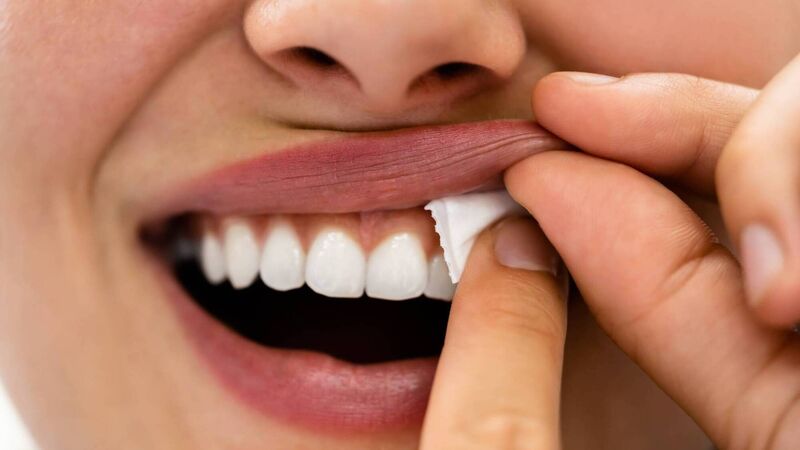Why teens are becoming addicted to nicotine pouches — even using them in class


Manufacturers may even be enticing young people to try these products. Smyth thinks so.
“They are targeting them in an attempt to get them addicted to nicotine,” he says. “Cigarettes used to be the gateway to nicotine addiction, but changes to the law and public perception mean that few young people smoke now. So the industry needs new gateways. First, it was vapes. Now, it’s pouches. But no matter whether it’s cigarettes, vapes, or pouches, nicotine is addictive.”
The pouches are made from nicotine in the form of powder or salts, mixed with fillers, such as microcrystalline cellulose (refined wood pulp), sweeteners, like xylitol and maltitol, flavourings, and preservatives.
A pouch can be tucked between the gum and upper or lower lip to deliver a nicotine high. “You can keep them there for as long as you like, while the nicotine, which is a stimulant, is absorbed into the bloodstream via the mucous membranes in the mouth,” says Mark Murphy, senior policy manager with the Irish Heart Foundation.
“From there, it moves to the gland that pumps out adrenaline, which increases your blood pressure, breathing rate, and heart rate.”
The nicotine hit delivered by these pouches can be substantial, says Smyth. A single cigarette typically contains between 6mg and 12mg of nicotine, or 240mg in a pack of 20 cigarettes.
“But there are pouches being sold that contain 43mg per pouch and 20 pouches per can,” says Smyth. “That’s a total of 860mg and it only costs €5.50, which is very affordable for kids.”
He is concerned about potentially fatal nicotine overdoses in children and cites a paper published in July, which found that a dose of 10mg per kilo of weight could kill a child.
“A young teen could weigh 40kg,” he says. “So a fatal overdose could be 400mg. This single pack of pouches contains double that.”

Dr Jessica Kent is an emergency doctor and medical toxicologist in Toronto, Canada. Last year, she published a paper on incidences of nicotine-pouch-induced toxicity in her hospital.
The paper detailed a 21-year-old man who had read that nicotine pouches could help as a study aid and used 15 of them over a 12-hour period. When he arrived at the hospital, he was nauseous, his blood pressure had skyrocketed, and he was confused.
Since then, all of the cases of nicotine-pouch-induced toxicity that Kent has seen have involved children and young people. “The fact these pouches come in brightly coloured containers and in flavours that taste good makes them especially enticing to toddlers, who tend to put everything in their mouths anyway,” says Kent. “A single pouch could cause toxicity in such a small child.”
The effects of this toxicity can be wide-ranging. Mild effects include nausea, vomiting, and confusion, while severe cases can involve seizures and respiratory failure that requires a breathing tube.
From her experience of treating young people who have suffered the ill effects of using pouches, Kent says they are generally unaware of the risks. “Because these products are legal and widely available, many assume they must be safe,” she says. “The way these products are marketed, as a healthier alternative to cigarettes, with slogans exclaiming they are 100% tobacco-free, is another factor.”

The Irish Heart Foundation (IHF) is adamant that pouches should not be considered safe. “They may contain fewer harmful toxins than cigarettes, but that’s not to say they are harm-free,” says Murphy.
“ A 2022 report by the German Federal Institute for Risk Assessment shows that nicotine has strong effects on the cardiovascular system and that pouches are high risk for children, pregnant and breastfeeding women, and those with cardiovascular disease. Our advice is that any use of nicotine should be avoided.”

Dr William Rymer, president of the Irish Dental Association, points out that nicotine worsens anxiety and sleep and he warns that pouches are likely to impact oral health. His fellow dentists have already seen nicotine pouch users with dry mouths, receding gums, and blisters on the sites where they regularly place their pouches.
He refutes arguments that pouches function as smoking-cessation aids and worries they will turn young people in to addicts, instead, just as vapes did before them.
“Nicotine is one of the world’s most addictive substances,” Rymer says. “There was a brief time when vapes were lauded as smoking-cessation aids, but look at the devastating impact of that, in terms of the number of young people now using them. The same is likely to be true of pouches.”
The IHF wants the public to know that the younger the person is when they start using nicotine, the more likely they are to become addicted.
“Worryingly, the US Centre for Disease Control and Prevention has also reported that adolescents who use nicotine may also be at increased risk for addiction to other drugs,” adds Murphy.
Nicotine can also take a toll on adolescent brain development. Smyth explains that “our brains continue forming until our mid-20s and are malleable during that time. They are also more prone to being damaged by addictive substances like nicotine.
“Not only do these pouches represent a new way of getting teenagers addicted to nicotine, but they also pose a risk to their long-term brain and mental health.”
Several studies highlight the damaging effects of nicotine on the brain. A 2023 study found a link between nicotine dependence and lower academic performance. One in 2013, suggested it could cause ADHD-type symptoms, while a 2006 study found that smokers were twice as likely to have depression.
As someone who has devoted his career to publicising the dangers of nicotine, Clancy was proud of the progress made after the smoking ban in 2004.
“The number of children who smoked began to decline and continued to decline until vapes came along,” he says.
Mistakes were made then, and he believes the same mistakes are being repeated now. “The addictiveness and harm caused by vapes were downplayed, and teenagers were allowed to use them.
“We’re doing the same thing with pouches, and we’re beginning to see a rise in total nicotine usage in children as a result. The 2024 ESPAD survey found that 36.4% of 16-year-olds had used some form of nicotine, and 19.6% were current users. Why are we allowing our young people to try any sort of nicotine?”
Smyth points out that Ireland’s first vape shop opened in 2010, but it took the Government until 2023 to ban their sale to people under 18. “With pouches, the regulators are years behind the nicotine industry once again,” he says.
“The Government seems to react after the fact again and again, and it’s young people who deal with the fallout.”
In response to a query about the legal situation regarding the sale of pouches, the Department of Health confirmed they were not covered by any domestic or EU tobacco control legislation, so the minimum age of sale did not apply.
Efforts are being made to remedy this situation, with a spokesperson stating that “the minister for health has requested the EU Commission to introduce a revised tobacco products directive as soon as possible”.
The IHF sees such regulation as essential. “The tobacco industry, which owns most nicotine pouch products, has a long history of targeting young people,” says Murphy. “They are always innovating, and it’s no surprise that these products are being heavily promoted just when new laws are coming in to tackle youth vaping.
“The Government must pass forward-thinking legislation that futureproofs against potential new products that are designed to make addicts of children.”
France and the Netherlands have already banned the sale of nicotine products outright and the IHF would like to see Ireland follow suit.
“Prohibiting these products entirely would be a far more practical way of protecting youth health and preventing addiction,” says Murphy. “ There’s an urgent need to raise awareness while we await any form of legislation.”
Kent wants young people to realise that “attractively packaged and flavoured pouches may seem innocuous, but their use comes with risks. People have to be told that nicotine is always going to be harmful and addictive. In the initial case that prompted my paper, my young patient said he would never have used so many pouches had he known the risks.”
Moves are being made to present young people with the full facts about nicotine pouches.
According to the Department of Health, the HSE is currently developing a youth vaping prevention media programme, which will also address other nicotine products, such as pouches.
Clancy believes there is an urgent need for a counter message to be spread about nicotine pouches.
“They may give people a bit of a kick by increasing their heart rate, but there is no evidence that they enhance any sort of performance, sporting, academic or otherwise,” he says.
“Instead, all of the evidence is pointing to nicotine being a harmful and addictive substance, especially for young people.
“We also know that if you don’t use nicotine in your teens, you’re unlikely to use it at all.
“We have already turned teens off the idea of smoking cigarettes. Now we need to turn them off the idea of nicotine altogether.”

Celebrating 25 years of health and wellbeing







